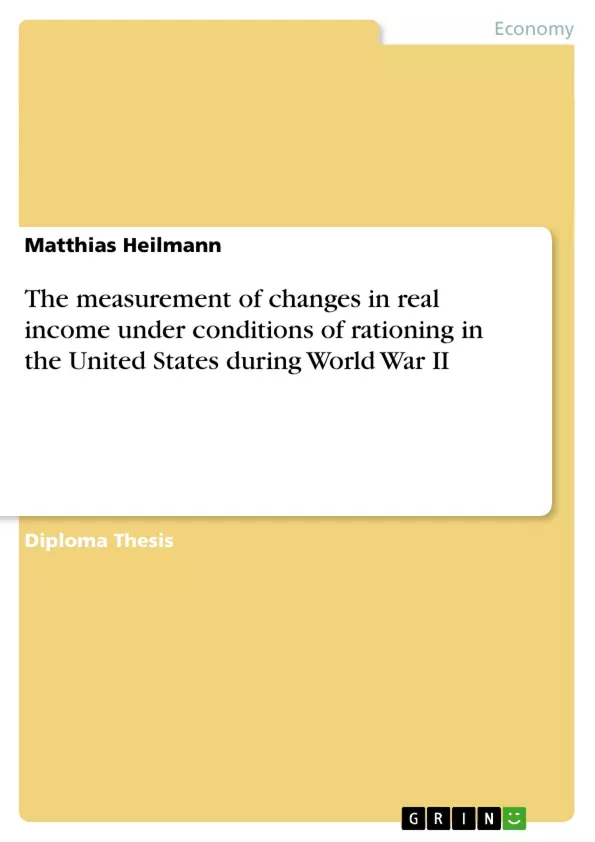[...] First, I will give an overview of the U.S. economy in chapter 2. After
having done that, I will present several aspects concerning the calculation
of a Rothbarian virtual price system. Thereby, it will be important
to build an opinion about the preferences of the private households,
which will be expressed as a generalized Cobb-Douglas demand system.
Based upon that demand system an estimation equation for the households'
preferences will be derived in section 3, followed by an ordinary
least squares regression of the preference parameters.
The second important step will be a presentation of the basic information
we can win from index number theory. It will be especially
interesting to say a few words about economic index number theory
(see chapter 4.2).
The combination of the outcomes from estimation with index number
theory makes up the most important step to unlock hidden dierences
between wartime-prices and postwar prices, i.e. I will compare wartime
demand to postwar demand and the impact of rationing on changes
in income. This procedure will be done by calculating deators using
both the estimated demand behavior and virtual prices.
In every section, I will present both the basic theoretical aspects,
which will help the reader understand the steps to deators, and applied
theory, i.e. estimations using empirical data in most cases.
Inhaltsverzeichnis (Table of Contents)
- 1. Introduction
- 2. The data and some key facts and figures
- 2.1. Data
- 2.2. Key economic indicators of the U.S. economy
- 3. Estimating the households' demand system
- 3.1. Deriving the estimation equation
- 3.2. The estimation of the households' preferences using the method of ordinary least squares
- 3.2.1. A general view on linear models.
- 3.2.2. The OLS-estimation
- 4. Discrepancies in demand and exact deflators
- 4.1. Differences between actual and notional demand.
- 4.2. An outline of index number theory
- 4.3. Exact deflators
- 5. Conclusion
Zielsetzung und Themenschwerpunkte (Objectives and Key Themes)
This paper aims to measure changes in real income under conditions of rationing in the United States during World War II. This involves the estimation of a demand system and the calculation of exact deflators for real income comparisons. The study focuses on understanding the impact of wartime rationing on household spending patterns and real income levels.
- Measurement of real income change during wartime rationing.
- Estimation of a demand system for households.
- Calculation of exact deflators to account for price and quantity changes.
- Analysis of discrepancies between actual and notional demand.
- Impact of rationing on household consumption patterns.
Zusammenfassung der Kapitel (Chapter Summaries)
- Chapter 1: Introduction This chapter provides an overview of the research topic and its significance. It highlights the challenges of measuring real income changes during wartime rationing and outlines the research objectives.
- Chapter 2: The data and some key facts and figures This chapter presents the data used for the study, including key economic indicators of the U.S. economy during the war. It provides a detailed description of the data sources and their limitations.
- Chapter 3: Estimating the households' demand system This chapter focuses on estimating the households' demand system, using the method of ordinary least squares. It explains the derivation of the estimation equation and discusses the results of the estimation.
- Chapter 4: Discrepancies in demand and exact deflators This chapter examines the discrepancies between actual and notional demand and presents an outline of index number theory. It then discusses the calculation of exact deflators for real income comparisons.
Schlüsselwörter (Keywords)
This research focuses on the measurement of real income changes under wartime rationing, using a demand system estimation and exact deflators. Key concepts include household consumption patterns, rationing, price indices, index number theory, and the impact of wartime economic conditions on consumer behavior.
- Citation du texte
- Matthias Heilmann (Auteur), 2003, The measurement of changes in real income under conditions of rationing in the United States during World War II, Munich, GRIN Verlag, https://www.grin.com/document/17272



